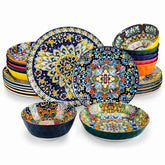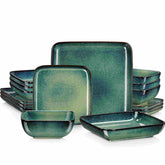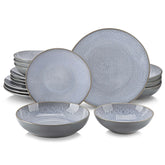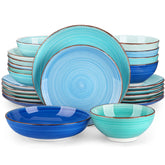Warming Winter Meals: Selecting Soup Bowls to Beat the Chill
Navigation
- Heat Retention: The Science and Significance in Winter Dining
- Material Matters: Finding Your Perfect Winter Soup Bowl
- Design Details That Keep the Warmth In
- How to Improve Your Meal with Colors and Accessories
- Beyond the Bowl: Accessories That Accentuate Warmth
- Picking the Best Winter Soup Bowl
When the cold weather arrives, there is nothing more comforting than a hot bowl of soup. The warmth of a hot bowl in your hands, the aroma of the steam rising from the bowl, and the sensation of the heat penetrating your fingers are some of the small comforts that make even the worst winter day endurable. However, this comforting experience is not solely dependent on the soup; the right soup bowl can enhance this warmth, making sure that each spoonful remains hot and is consumed to the optimum.
Heat Retention: The Science and Significance in Winter Dining
1. The Science behind Heat Retention and Its Importance in Winter Dining
During the cold season, the warmth that comes with a bowl of soup is essential in making one feel warm for a long time. The ability of soup bowls to retain heat is determined by the material used and the design of the bowl. Some materials are better at holding heat than others, so your soup stays hot for a longer time. Since winter meals require the food to be kept warm for a longer period, it is advantageous to select bowls that are heat resistant.
2. Comparing Common Materials for Insulation Properties
The material of your soup bowl is very important in determining how long your soup will remain warm. Some of the materials that are used in cooking, like porcelain, stoneware, and ceramic, are good heat retainers. Porcelain has a delicate structure that insulates effectively, meaning it retains heat without making the bowl too hot to handle comfortably. Stoneware is denser than other materials and it is great at holding heat, which is perfect for long and relaxed meals. On the other hand, materials such as glass or plastic are known to be bad conductors of heat and therefore, one has to finish his or her soup very fast because it will be cold after some time.
Material Matters: Finding Your Perfect Winter Soup Bowl
1. Porcelain's Elegance and Insulation Qualities
Porcelain bowls, associated with fine dining, are not only elegant but also provide more than just a touch of elegance. Despite their slim profile and intricate patterns, porcelain is one of the most effective materials at holding heat. Since porcelain effectively insulates heat, your soup will remain warm for a longer time and you can take your time to enjoy your meal without the soup getting cold. Also, porcelain is an insulator, and this means that the outer surface of the bowl will not be hot to touch, and you can comfortably hold the bowl without burning your hands.
2. Stoneware's Strength and Rustic Charm
For those who prefer a heavier and rougher look, stoneware bowls are ideal for use. Stoneware is denser and thicker than porcelain and is perfect for holding heat in winter dishes. Stoneware is a very heavy material that retains heat for a long time, so your soup will remain warm during the meal. Its rough and natural look is ideal for pairing with thick winter soups and stews, thus adding to the warmth of the meal.
Design Details That Keep the Warmth In
Besides the material used in the construction of the soup bowl, the shape of the bowl is also very crucial. In terms of soup holding heat, deep bowls are found to be better than shallow ones.
A deep bowl has less surface area exposed to the air hence less heat loss. This makes it possible for the soup to remain hot for a longer period of time and therefore the temperature of the soup is consistent with the temperature of the spoon. However, shallow bowls, as much as they are fashionable, tend to cool soup more quickly because more of the surface area is exposed to the surrounding air. If you want to get the most heat retention, then a deep curved bowl is the way to go.
How to Improve Your Meal with Colors and Accessories
Color Theory and Warm Tones for an Appetite Appeal
Color is another aspect that can be used to improve the appearance of your meal. Colors such as red, orange, and yellow are warm colors and they are associated with warmth and comfort and therefore suitable for winter soup bowls. These colors not only make the place warm and welcoming but also help to make the guests hungrier, which is always a plus when it comes to dining. Just think about how a bowl of butternut squash soup served in a golden bowl looks when placed in a deep, warm-toned bowl; the warmth of the bowl complements the warmth of the food and makes the meal even more enjoyable on many levels.
Beyond the Bowl: Accessories That Accentuate Warmth
To make your dining experience even warmer, you can add accessories that are made for soup bowls to make your dining experience even better. One great option is a soup bowl cozy, a fabric cover that wraps around the bowl to offer extra insulation. This not only helps to keep the soup warm for a longer period of time but also shields your hands from the heat of the bowl so that you can comfortably hold the bowl while enjoying your meal. Another very useful accessory is lids for soup bowls, which are perfect for placing on the bowl to keep the steam in and heat from evaporating while you work on the rest of the meal. Lids are particularly helpful when there are several dishes on the table or when eating in the open during the evening chill.
Also, serving soup with warm, freshly baked bread adds another level of warmth to the meal. The bread can be crusty or soft rolls, and it complements the soup by providing a contrasting texture and can be dipped into the soup or eaten separately. The warmth of the bread not only increases the temperature of the meal but also adds to the comfort that is associated with winter meals. All these accessories and side elements transform a bowl of soup into a complete, warm, and satisfying meal.
Picking the Best Winter Soup Bowl
A winter soup bowl is meant to keep your meal warm and appetizing on cold days. You need to look at the material with which it's made, for instance, porcelain or stoneware that retains heat well. The shape of the bowl is important, too; some are specially made in such a way as to keep your soup at an ideal temperature for a longer period. Color up your meal, accessorize it to make eating even more fun, and turn meals into comforting moments. The right bowl makes these soups steam from the first sip to the last, just to taste the warm flavors of winter.













